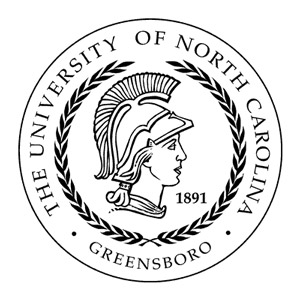How long has Minerva been associated with UNCG? An 1894 diploma in our Archives (the earliest diploma we have) proudly displays Minerva within the seal.
It is strictly conjecture, but certainly plausible that the school’s founder, Charles Duncan McIver, is the person responsible for selecting Minerva. McIver won a medal in Greek and honors in Latin while attending The University of North Carolina at Chapel Hill. Edwin Alderman, a former classmate and charter member of the school’s faculty, was also in the classics course at Chapel Hill, and is another possible source for the use of Minerva on the school seal. Whoever is ultimately responsible for the selection, a short history of the goddess reveals why she was such an apt choice for the school.
Minerva was a Roman goddess whose origin is believed to be Etruscan, her Etruscan antecedent being known as Menrva. Menrva was the third part of the Etruscan holy triad composed of Tinia and Uni, which is later reflected in the Roman Capitoline Triad of Jupiter, Juno, and Minerva. By the time Minerva was worshipped along with Jupiter and Juno in temples known as Capitolia, Minerva was visually indistinguishable from the Greek goddess Athena. People of the classical world had no problem borrowing gods from other cultures!
 |
| Bronze votive figurine of Minerva, she originally held a spear in her right hand and shield in her left. (Image from Dictionary of Roman Religion, Lesley Adkins & Roy Adkins, 1996) |
Throughout her history and various guises, the goddess has been associated with many aspects of worship. She was a tutelary goddess in Athens and to a lesser extent, Rome. She was associated with aspects of war and this is evident in numerous depictions of her in arms (notice the war helmet in the seals and figurine). She was a goddess of arts, crafts, teaching, and music (she invented the flute), and in these aspects enjoyed festivals called Quinquatria held in her honor in Rome. As Minerva Medica (also Athena Hygeia) she was the goddess of healing.
If all these aspects seem disjointed (Latin poet Ovid calls her the “goddess of a thousand things”), it helps to keep in mind that she is most renowned for her wisdom and mental prowess. Was it most likely this aspect that McIver had in mind when he chose her as our representative goddess? Perhaps so, but he may have also read and heeded the words of Ovid’s Fasti, “Una dies media est, et fiunt sacra Minervae…quod est illa nata Minerva die…Pallada nunc pueri teneraeque orate puellae, qui bene placarit Pallada, doctus erit” or “After an interval of one day, rites are performed in honor of Minerva…because that is her birthday…Make your prayers to Pallas* (Minerva) boys and gentle girls, those who honor her well, will be learned!” (Fasti 3.809-816) A very appropriate verse for a teacher’s school!
As the University has grown, it is interesting to see how many of her other aspects have been fulfilled with the mission of the University. From teacher education and home economics, to the inclusion of arts, music, and even nursing degrees being offered, Minerva has proven a very wise choice for The University of North Carolina at Greensboro.
(*Pallas is another name for Athena/Minerva-)
Article by Scott Hinshaw

